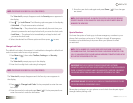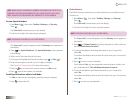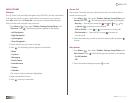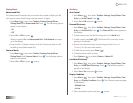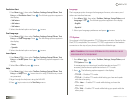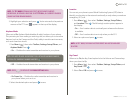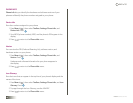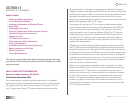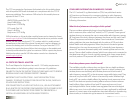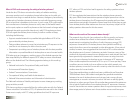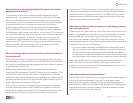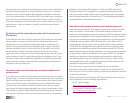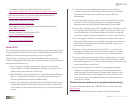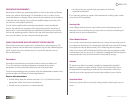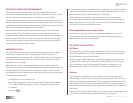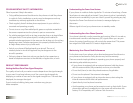
84
BACK to TOC
seCtIon 13 HEALTH AND SAFETY INFORMATION
TheFCChasgrantedanEquipmentAuthorizationforthismobilephone
with all reported SAR levels evaluated as in compliance with the FCC RF
exposure guidelines. The maximum SAR values for this model phone as
reported to the FCC are:
AMPS/CDMA mode (Part 22):
Head: 0.488 W/Kg
Body-worn: 0.378 W/Kg
PCS mode (Part 24):
Head: 1.46 W/Kg
Body-worn: 0.571 W/Kg
SAR information on this and other model phones can be viewed on-line at
www.fcc.gov/cgb/sar. To find information that pertains to a particular model
phone, this site uses the phone FCC ID number which is usually printed
somewhere on the case of the phone. Sometimes it may be necessary to
remove the battery pack to find the number. Once you have the FCC ID
number for a particular phone, follow the instructions on the website and
it should provide values for typical or maximum SAR for a particular phone.
Additional product specific SAR information can also be obtained at
www.fcc.gov/cgb/sar.
UL CERTIFIED TRAVEL ADAPTER
The Travel Adapter for this phone has met UL 1310 safety requirements.
Please adhere to the following safety instructions per UL guidelines.
FAILURE TO FOLLOW THE INSTRUCTIONS OUTLINED MAY LEAD TO SERIOUS
PERSONAL INJURY AND POSSIBLE PROPERTY DAMAGE
IMPORTANT SAFETY INSTRUCTIONS - SAVE THESE INSTRUCTIONS.
DANGER - TO REDUCE THE RISK OF FIRE OR ELECTRIC SHOCK, CAREFULLY
FOLLOW THESE INSTRUCTIONS.
FOR CONNECTION TO A SUPPLY NOT IN THE U.S.A., USE AN ATTACHMENT
PLUG ADAPTER OF THE PROPER CONFIGURATION FOR THE POWER OUTLET.
THIS POWER UNIT IS INTENDED TO BE CORRECTLY ORIENTATED IN A
VERTICAL OR HORIZONTAL OR FLOOR MOUNT POSITION.
CONSUMER INFORMATION ON WIRELESS PHONES
The U.S. Food and Drug Administration (FDA) has published a series
of Questions and Answers for consumers relating to radio frequency
(RF) exposure from wireless phones. The FDA publication includes the
following information:
What kinds of phones are the subject of this update?
The term wireless phone refers here to hand-held wireless phones with
built-in antennas, often called “cell,” “mobile,” or “PCS” phones. These types of
wireless phones can expose the user to measurable radio frequency energy
(RF) because of the short distance between the phone and the user’s head.
These RF exposures are limited by Federal Communications Commission
safety guidelines that were developed with the advice of FDA and other
federal health and safety agencies. When the phone is located at greater
distances from the user, the exposure to RF is drastically lower because a
person’s RF exposure decreases rapidly with increasing distance from the
source. The so-called “cordless phones,” which have a base unit connected to
the telephone wiring in a house, typically operate at far lower power levels,
and thus produce RF exposures well within the FCC’s compliance limits.
Do wireless phones pose a health hazard?
The available scientific evidence does not show that any health problems
are associated with using wireless phones. There is no proof, however, that
wireless phones are absolutely safe. Wireless phones emit low levels of
radio frequency energy (RF) in the microwave range while being used. They
also emit very low levels of RF when in the stand-by mode. Whereas high
levels of RF can produce health effects (by heating tissue), exposure to low
level RF that does not produce heating effects causes no known adverse
health effects. Many studies of low level RF exposures have not found
any biological effects. Some studies have suggested that some biological
effects may occur, but such findings have not been confirmed by additional
research. In some cases, other researchers have had difficulty in reproducing
those studies, or in determining the reasons for inconsistent results.



